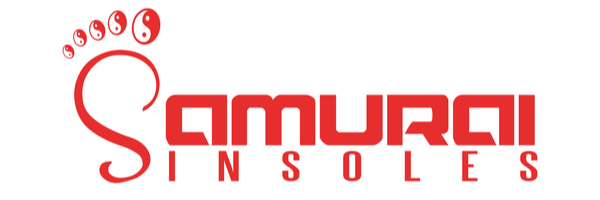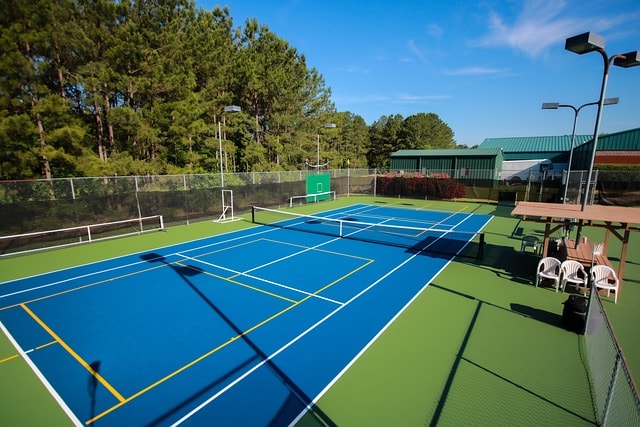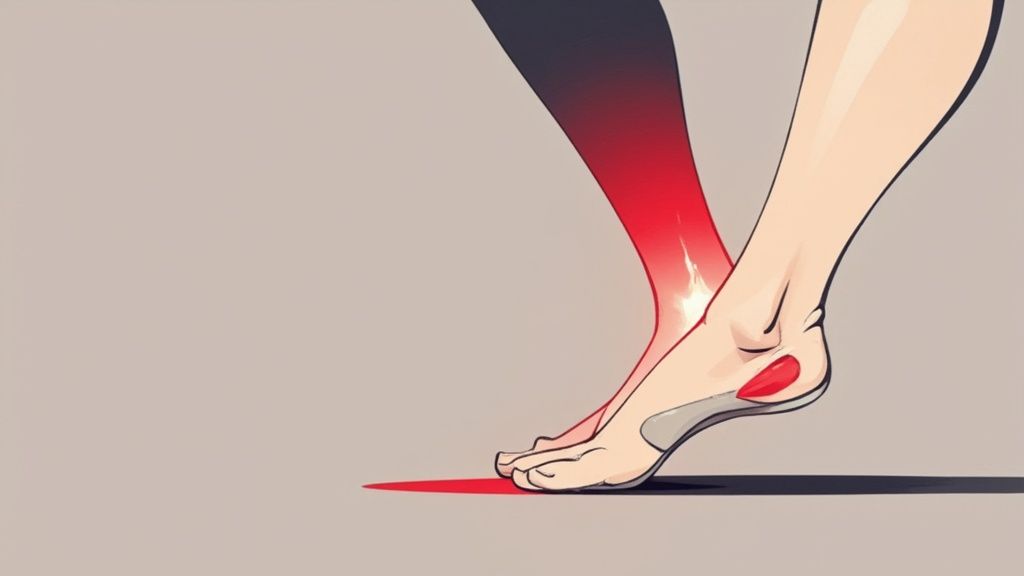Understanding What's Really Happening In Your Foot
That sharp, stabbing pain that greets you with your first step out of bed isn’t just some random ache. It’s a definite signal from a critical part of your foot’s structure: the plantar fascia. To figure out how to get lasting relief, you first need to get what’s going on down there. Picture your plantar fascia as a tough, bowstring-like band running along the bottom of your foot, connecting your heel to your toes. Its main job is to support your arch and absorb the massive shock from every single step, jump, or run you take.
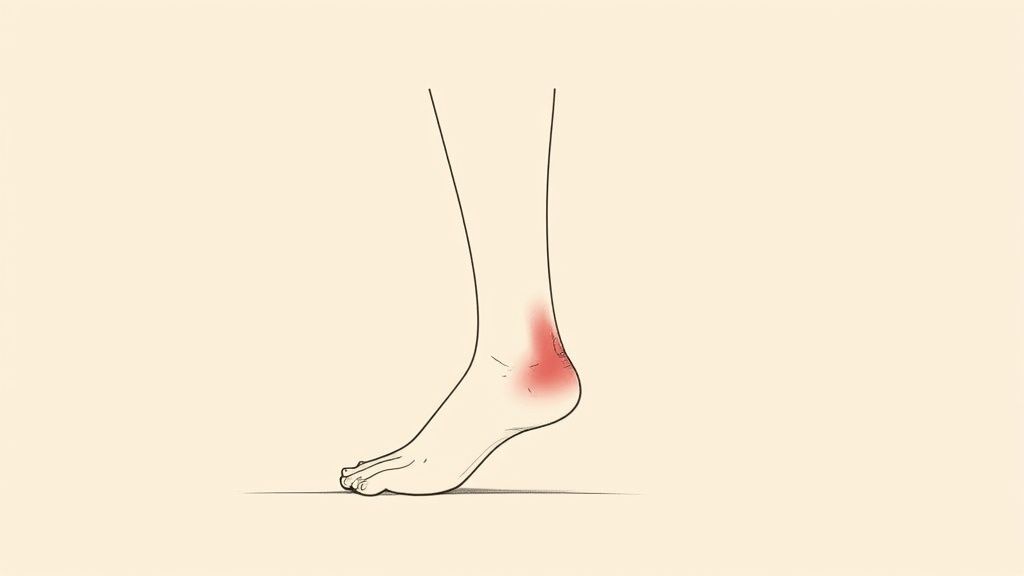
Why Is It So Painful?
When you see "-itis" tacked onto a medical term, it usually signals inflammation. For a long time, everyone thought plantar fasciitis was just that—an inflamed ligament. But our understanding has shifted. It’s now seen more as a degenerative issue. Instead of simple swelling, the ligament is actually suffering from tiny micro-tears caused by repeated strain. Your body keeps trying to repair these tears, but if the stress doesn't let up, it just can't keep pace. This leads to a messy, weakened tissue structure, a condition more accurately called fasciosis.
This new perspective explains why the pain is so brutal after you've been off your feet, like overnight. While you sleep, the fascia tightens up. That first morning step forces a sudden stretch on this damaged, tender tissue, causing that infamous sharp pain. As you move around, the area warms up and loosens, which is why the pain often fades into a more manageable, dull ache.
From Strain to Chronic Pain
This cycle of damage and incomplete healing is where the real problem starts. And it’s incredibly common. Studies suggest that plantar fasciitis will affect about 10% of people worldwide at some point, and in the U.S. alone, around 2 million people seek treatment for it each year. You can learn more about these global statistics and see just how many people are dealing with this frustrating condition.
The path from a healthy foot to one in chronic pain isn't a sudden event; it's the result of stress piling up over time. Several things can push your feet over the edge:
- Sudden activity changes: Maybe you decided to jump into a new running program too fast or took a job that has you standing all day.
- The wrong shoes: Footwear without proper arch support or cushioning does a poor job of absorbing shock, forcing your fascia to take the hit.
- Your foot’s mechanics: Things like flat feet or very high arches can change the way you walk, distributing your weight unevenly and straining the ligament.
- Tight muscles: A tight Achilles tendon or calf muscles can tug on your heel bone, which in turn yanks on the plantar fascia.
Getting a handle on these mechanical issues is the first real step toward getting better. When you know why your foot is protesting, you can do more than just manage the pain—you can start fixing the root cause. You might want to check out our deep dive into what causes plantar fasciitis. This knowledge gives you the power to choose treatments and make lifestyle changes that will actually help your foot heal for good, not just put a temporary band-aid on it.
Quick Relief Strategies That Actually Make a Difference
When that first step out of bed feels like you're walking on glass, you need relief that works now, not weeks from now. While the ultimate goal is long-term healing, managing the immediate, sharp pain is crucial for just getting through your day. Let's look at a few things you can do for some real, tangible relief when you need it most.

Smart Icing and Gentle Massage
You can skip fumbling with a leaky bag of frozen peas. A far better way to ice your foot is to use something that perfectly matches the curve of your arch. A frozen water bottle is the ideal tool for this. Just sit down and roll your foot over it for about 15-20 minutes. The cold helps numb the pain and calms down that fiery inflammation, while the rolling action gives your tight fascia a gentle massage.
If you want to dig in a bit deeper, a lacrosse ball or even a simple golf ball can be incredibly effective.
- Find a comfortable chair and place the ball under your foot.
- Slowly roll it from your heel up toward your toes, applying as much pressure as feels right.
- When you hit a sore spot that feels particularly tight, just pause and hold that pressure for 15-30 seconds before you continue rolling.
- A few minutes of this, a couple of times a day, can make a huge difference.
This simple massage helps to break up tight spots and encourages blood flow, which is a key part of how to heal plantar fasciitis. If you're looking for more ideas, we share several in our guide on how to treat plantar fasciitis with real relief strategies.
Managing Pain Without Over-Relying on Pills
While it's tempting to reach for over-the-counter anti-inflammatories like ibuprofen on really bad days, they aren't a permanent fix. A smarter approach is to tackle the source of the strain. Kinesiology tape, for example, can offer surprising support by gently lifting the skin and underlying tissue, which can take some pressure off your plantar fascia. It's a fantastic way to survive a long day on your feet without being in constant agony.
The financial side of this condition is a serious consideration. The total annual cost for treating plantar fasciitis in the U.S. is estimated to be a massive $284 million. On an individual level, studies show that about 93% of adults with this condition pay out-of-pocket for pain management every single month. You can read more about the economic impact of plantar fasciitis on KURU Footwear. This really highlights why finding sustainable, low-cost methods like massage and proper support is so important. These quick-relief tactics aren't just a temporary patch; they're the foundational steps that allow you to stay mobile enough to do the stretches and exercises that will fix the problem for good.
Movement and Stretching Routines That Transform Recovery
While quick fixes like ice packs offer some immediate comfort, true, long-term healing from plantar fasciitis comes from actively working on the muscles and tissues involved. This isn't about just randomly pulling on your toes; it's about a dedicated routine that loosens the tight spots and shores up the weak areas that likely caused the problem in the first place. This is how you shift from simply managing pain to actually fixing the root cause.

Morning Rituals to Ease That First Step
We’ve all been there—that dreaded first step out of bed that feels like walking on glass. This sharp pain happens because the plantar fascia, the ligament at the bottom of your foot, tightens up overnight while you sleep. The goal is to gently wake it up and prepare it for the day before you put any weight on it.
A couple of simple, pre-alarm clock stretches can make a world of difference:
- Towel Stretch: Before you even swing your legs out of bed, grab a towel or a yoga strap. Loop it around the ball of your foot, keep your knee straight, and gently pull back. You should feel a nice, deep stretch in your calf and along the bottom of your foot. Hold this for 30 seconds, release, and then do it two more times. Don't forget the other foot!
- Foot Alphabet: Sit on the edge of your bed and pretend your big toe is a pen. Trace out the letters of the alphabet in the air, from A to Z. This simple movement takes your ankle through its full range of motion, warming up the joint and the fascia.
Making these two moves a non-negotiable part of your morning can drastically reduce that initial jolt of pain and set a much better tone for your entire day.
To give you a better idea of what to focus on, here's a breakdown of the most effective stretches. This table compares different techniques, so you can build a routine that works best for you.
| Stretch Type | Target Area | Duration | Frequency | Effectiveness Rating |
|---|---|---|---|---|
| Towel Stretch | Plantar Fascia & Calf | 30 seconds | 2-3 times daily, especially in the morning | ★★★★★ |
| Wall Calf Stretch | Gastrocnemius (upper calf) | 30 seconds | 2-3 times daily | ★★★★★ |
| Bent-Knee Calf Stretch | Soleus (lower calf) | 30 seconds | 2-3 times daily | ★★★★☆ |
| Foot Alphabet | Ankle Joint & Foot | 1-2 minutes | Daily, especially in the morning | ★★★☆☆ |
| Rolling Stretch | Plantar Fascia | 1-2 minutes | Twice daily | ★★★★☆ |
As you can see, consistency and targeting both the plantar fascia and the calf muscles are key. The calf stretches are particularly important because a tight calf muscle pulls on the heel bone, adding tension to the plantar fascia.
Strengthening for Lasting Stability
Stretching is great for flexibility, but strengthening is what builds resilience and prevents the pain from coming back. Think of it this way: weak foot and calf muscles aren't doing their job of supporting your arch. This forces the plantar fascia to pick up the slack, leading to overuse and injury.
Adding these strengthening exercises to your routine is crucial for a full recovery:
- Towel Curls: Find a seat, place your feet flat on the floor, and spread a small towel out in front of you. Using just your toes, scrunch the towel toward you until it's all bunched up. Then, use your toes to push it back out flat. Keep this up for a minute or two. It's tougher than it sounds!
- Calf Raises: Stand facing a counter or wall for balance. Slowly rise up onto the balls of your feet, hold for a count, and then slowly lower your heels back to the floor. Start with 2-3 sets of 15 repetitions. Once that feels easy, you can challenge yourself by doing them one leg at a time.
These movements build up the small intrinsic muscles in your feet and the larger muscles in your lower legs, creating a robust support system for your arch. This directly reduces the daily strain on your plantar fascia, giving it the break it needs to finally heal. This is the difference between temporary relief and a permanent solution.
Finding Footwear and Support That Actually Helps
The stretches and exercises you're doing are a massive step forward, but if you put your newly-stretched feet back into unsupportive shoes, you're essentially taking one step forward and two steps back. Your daily footwear can either be a powerful tool for healing or the very thing that sabotages your recovery. Let's get honest about what's on your feet and figure out what actually works.
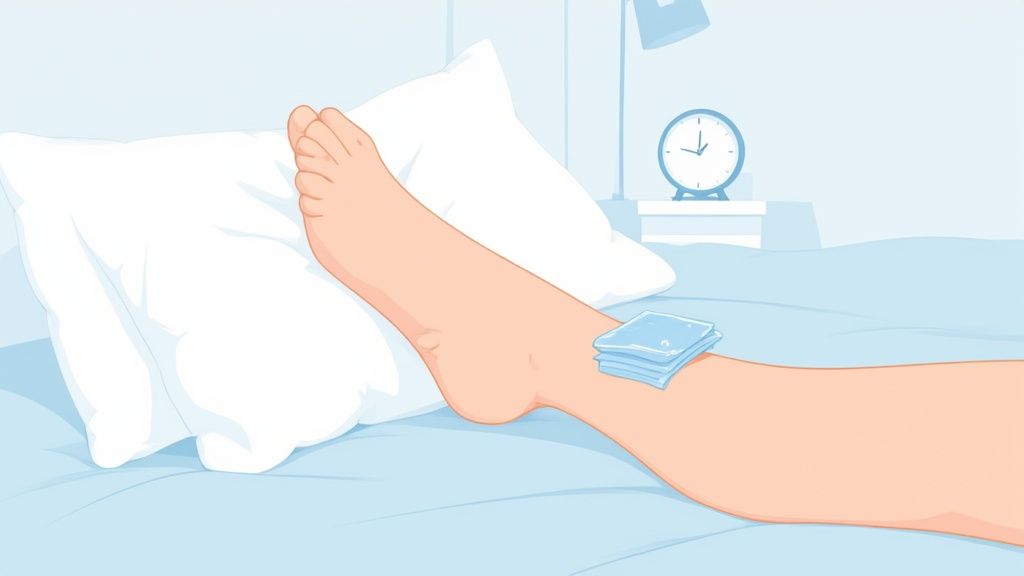
A Hard Look at Your Shoe Rack
Forget brand names and marketing claims for a second. Go to your closet and pick up the pair of shoes you wear most often. Can you easily bend it in half? Does it twist like a wet dishrag? If you answered yes, it’s probably offering zero support, forcing your plantar fascia to work overtime with every single step. These are the shoes that need to be retired, at least until you're completely pain-free.
A good shoe provides a stable foundation for your foot. You're looking for a few key characteristics:
- A firm heel counter: This is the cup-like structure at the back of the shoe. It should be stiff to prevent your heel from wobbling side-to-side.
- Solid arch support: This doesn't mean a giant, hard lump in the middle. It means the shoe’s overall structure supports your natural arch, preventing it from collapsing under pressure.
- Minimal mid-shoe flex: A supportive shoe should only bend at the ball of the foot, right where your foot naturally flexes to push off.
- Proper cushioning: This is crucial for absorbing the shock of walking on hard surfaces like concrete and pavement, which is a daily reality for most of us.
Think of your shoe as your first line of defense. It needs to do its job correctly so your plantar fascia doesn't have to overcompensate.
Insoles and Orthotics: The Next Level of Support
Even with a great pair of shoes, you might need more targeted help. This is especially true if you have specific foot mechanics, like overpronation (where your foot rolls inward excessively). This is where supportive insoles come in, and they can be a total game-changer in your healing journey.
A quality orthotic insole isn't just a flimsy foam insert; it's engineered to correct biomechanical problems. To help you choose, we've put together a comparison of different footwear features and support options.
Footwear Features for Plantar Fasciitis Recovery
Detailed comparison of essential shoe features and orthotic options, including effectiveness ratings and cost considerations.
| Feature/Product | Benefit | Cost Range | Effectiveness | Best For |
|---|---|---|---|---|
| Supportive Shoes | Provides a stable base, absorbs shock, and reduces overall foot strain. | $80 - $200 | Moderate | Daily wear, foundational support for everyone with plantar fasciitis. |
| Gel Heel Cups | Offers basic heel cushioning to absorb impact directly under the heel bone. | $10 - $25 | Low | Mild, localized heel pain; not for addressing underlying arch issues. |
| Off-the-Shelf Insoles | Provides general arch support and cushioning, better than stock shoe liners. | $30 - $80 | Moderate | Mild to moderate pain, people needing more support than their shoes offer. |
| Samurai Insoles | Engineered orthotic designed to control overpronation and support the arch. | ~$40 | High | People with overpronation, seeking targeted relief without a custom price tag. |
| Custom Orthotics | Molded specifically to your foot for precise correction of biomechanical issues. | $300 - $800+ | Very High | Severe cases, complex foot deformities, or when other options have failed. |
The right insole can provide the specific arch support your foot needs, cushion your heel precisely where it hurts, and guide your foot into a more neutral alignment. This takes a significant amount of strain off the plantar fascia, giving it the break it needs to finally heal.
To learn more about the science behind this, you can explore our guide on how plantar fasciitis insoles can fix your heel pain. They bridge the gap between a good shoe and the unique support your foot requires. Combining proper footwear with a well-designed insole creates a powerful healing environment, allowing you to stay active while making real progress toward a pain-free life.
When Conservative Treatment Isn't Enough
It’s a special kind of frustration when you’ve been doing everything right for months—stretching, icing, wearing better shoes—and your foot pain just won't quit. If this sounds like you, know that you're not alone. While conservative approaches work wonders for most, they aren't a silver bullet for everyone.
Statistically, these at-home treatments have a 90% success rate, which is fantastic news for the majority. You can read more about these treatment success rates on the NCBI website. But if you fall into that other 10%, it simply means it’s time to explore the next level of care with your doctor. This doesn't mean jumping straight to surgery; there are several highly effective, minimally invasive options to get you back on your feet.
Stepping Up Your Treatment Plan
When your pain becomes a stubborn, unwelcome guest, your doctor or physical therapist might suggest treatments that go beyond what you can manage at home. These methods are designed to break the cycle of chronic pain and inflammation by targeting the damaged tissue directly.
Some common next steps include:
- Cortisone Injections: Think of this as a powerful, targeted strike against inflammation. A steroid is injected right into the plantar fascia to calm a severe flare-up. It can provide significant pain relief, though it's sometimes temporary. Because repeated injections can potentially weaken the fascia, doctors often use them strategically to make physical therapy more manageable and effective.
- Extracorporeal Shockwave Therapy (ESWT): This non-invasive therapy uses high-energy sound waves to give your body’s healing process a wake-up call. The sound waves stimulate blood flow and trigger natural repair mechanisms in the chronically injured tissue, encouraging it to finally heal.
- Platelet-Rich Plasma (PRP) Therapy: This treatment uses your body's own healing power. A small amount of your blood is drawn, spun in a centrifuge to concentrate the healing platelets, and then injected back into the fascia. The goal is to flood the injured area with growth factors that can speed up tissue repair from the inside out.
Exploring Regenerative Therapies
For stubborn cases, some people look into therapies focused on cellular regeneration. For instance, exploring the benefits of substances like BPC-157, often called the ultimate recovery peptide, might be a conversation to have with a knowledgeable provider.
Being your own best advocate is key. Before moving forward with any procedure, make sure you ask your doctor about the success rates, potential side effects, and what the recovery process really looks like. Understanding all your options ensures you’re making a well-informed decision for the long-term health of your feet.
Building Habits That Keep You Pain-Free Long-Term
Getting out of pain is a huge deal, but the real win is making sure it doesn't come creeping back. This is where we move from actively treating the pain to smart, long-term maintenance. Lasting relief isn't about a lifetime of intense physical therapy; it's about weaving small, consistent habits into your day that protect your feet without becoming a chore. You're creating a new normal where foot health just happens in the background, instead of being a daily crisis.
Your New Maintenance Routine
Think of this as your personal insurance policy against future flare-ups. A good maintenance routine doesn't need to be complicated. It's usually just about continuing the most helpful parts of your recovery plan, just not as often. For most people, this looks something like this:
- A Quick Daily Stretch: Keep doing that 30-second calf stretch against the wall once or twice a day. It’s a tiny time commitment that pays off big by keeping the entire muscle chain from your legs to your feet nice and flexible.
- Weekly Strengthening: You don't have to do towel curls every single day for the rest of your life. But knocking them out two or three times a week is great for maintaining the strength of those important intrinsic foot muscles that hold up your arch.
- Consistent Support: This is a big one. Make supportive shoes and quality insoles your go-to choice, not just something you grab on bad days. This is probably the single most effective habit for preventing the strain that causes plantar fasciitis in the first place.
The Mayo Clinic points out several risk factors for plantar fasciitis, and many of them can be managed with these exact kinds of consistent habits.
This image really drives home why it's so important to manage things like your foot mechanics, weight, and the demands of your job. Long-term habits, like always wearing supportive footwear and staying active, directly address these root causes.
Catching Flare-Ups Before They Start
Your body is pretty good at giving you hints long before that sharp, "first step out of bed" pain returns. The trick is learning to listen to it. An early warning sign might be a dull ache after a long walk, a little stiffness in the morning that wasn't there before, or a tender spot in your arch. Don't brush these whispers aside.
When you feel that first twinge, don't panic—just act. This is your signal to dial up your self-care for a short time. That might look like:
- Tossing in an extra stretching session that day.
- Rolling your foot on a frozen water bottle for 15 minutes that evening.
- Making sure you wear your most supportive shoes the next day, no exceptions.
- Swapping your run for a brisk walk to give your feet a break.
Dealing with these issues when they're just a 1 or 2 on the pain scale is so much easier than letting them escalate to a 7 or 8. This proactive mindset is the key to healing plantar fasciitis for good. It turns what could be a major setback into a minor tune-up, keeping you active, healthy, and on your feet for the long haul.
Your Personal Recovery Action Plan
Alright, let's turn all this information into a practical plan that actually works for your life. Knowing how to heal plantar fasciitis is one thing, but consistently putting that knowledge into practice is what really makes a difference. Think of this as your personal framework to organize your efforts, see real progress, and keep your spirits up along the way.
Creating Your Daily, Weekly, and Monthly Checklists
Feeling overwhelmed is common, but a structured approach can make the process manageable. The secret weapon here is consistency, which is much easier to achieve with simple checklists.
Daily Habits (The Non-Negotiables): These are the small things you do every single day that build the foundation for healing.
- Morning Stretches: Before your feet even think about hitting the floor, grab a towel for that 30-second stretch. It's also a great time to trace the alphabet with your foot to get things moving.
- Supportive Footwear: This is a big one. From the moment you get out of bed, your feet should be in supportive shoes with good insoles. No more walking barefoot on hard tile or wood floors—it's like an open invitation for pain.
- Evening Roll-Out: While you're relaxing and watching TV, grab a frozen water bottle or a lacrosse ball. Spend about 5-10 minutes rolling out the arch of your foot. It's a simple way to soothe the tissue after a long day.
Weekly Goals (The Progress Makers): This is where you'll start to build strength and track how you're doing.
- Strengthening Sessions: Set aside time for 2-3 sessions of exercises like towel curls and calf raises. These are crucial for building the long-term foot stability that prevents future flare-ups.
- Assess Your Pain: Do a real check-in. Is the pain better, worse, or just hanging around? Using a simple 1-10 pain scale can help you be more objective than just going by "it hurts."
- Review Your Activity: Think back over the week. Did a long day of shopping or a new workout at the gym trigger a flare-up? Make a mental note of it so you can adjust your approach next time.
Monthly Milestones (The Big Picture): Looking at the bigger picture helps you see how far you've come.
- Celebrate Small Wins: Did you make it a whole week without that sharp morning pain? Did you take a walk you couldn't handle a month ago? Acknowledge it! This progress is what it's all about.
- Evaluate Your Gear: Give your shoes and insoles a quick look. Are the shoes still offering good support, or are they worn out? Are the insoles flattened? Making sure your equipment is still up to the task is essential.
Troubleshooting and Staying Motivated
Let’s be real: recovery is almost never a perfect, straight line. You're going to have fantastic days and some frustrating ones. When you hit a plateau or feel that familiar twinge of a flare-up, don't let it get you down. Go back to your daily checklist. Are you slipping on any of the basics? Often, a small setback is just your body telling you to double down on those core habits for a few days.
Healing takes time. You are literally repairing damaged tissue and teaching your muscles to work differently. By sticking to a structured plan, you’re giving your body the best shot at a full recovery.
The right support is the bedrock of this entire plan. Investing in a quality pair of orthotic insoles that control pronation and cushion your heel can make every other effort more effective. Give your feet the engineered support they deserve.
Discover how Samurai Insoles can be the cornerstone of your recovery plan and get you back to living pain-free.
